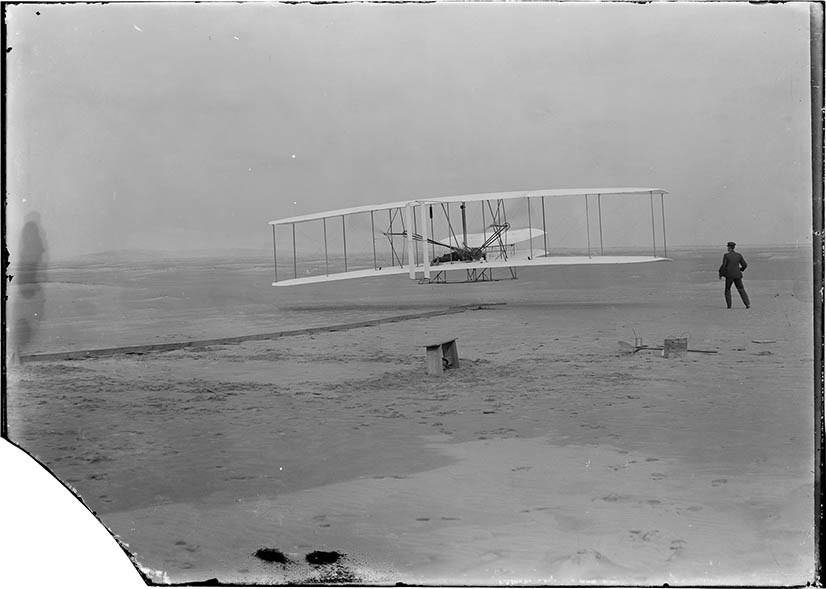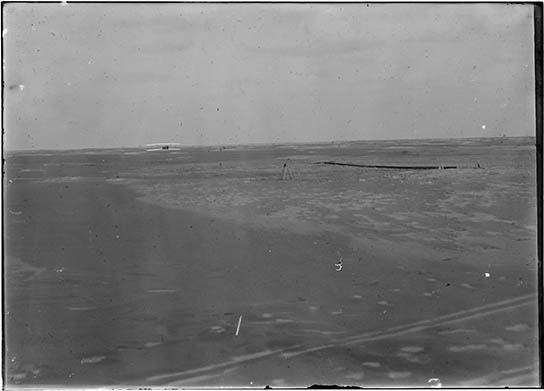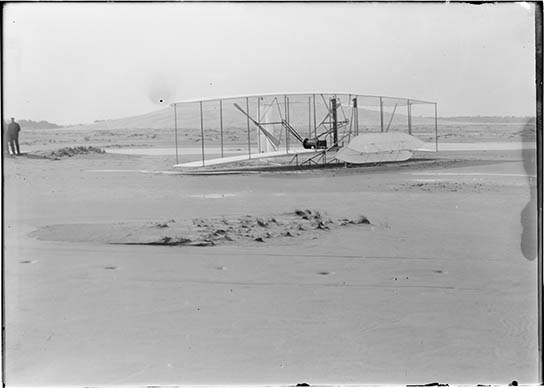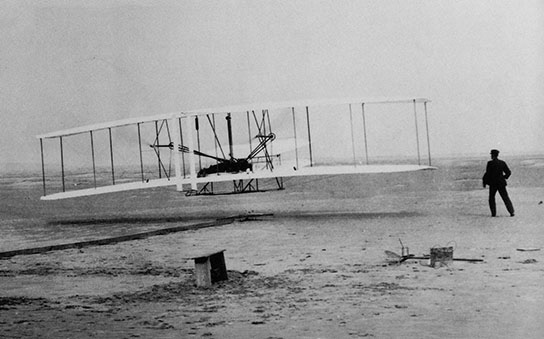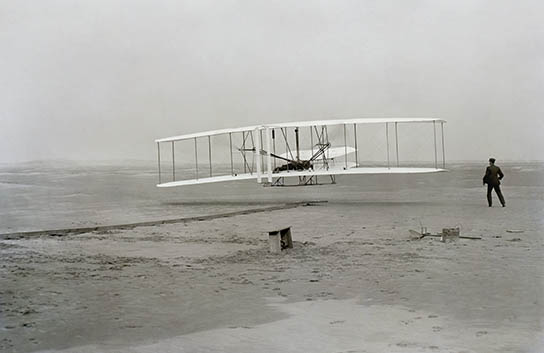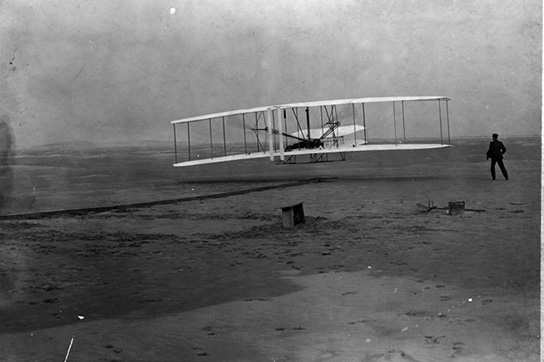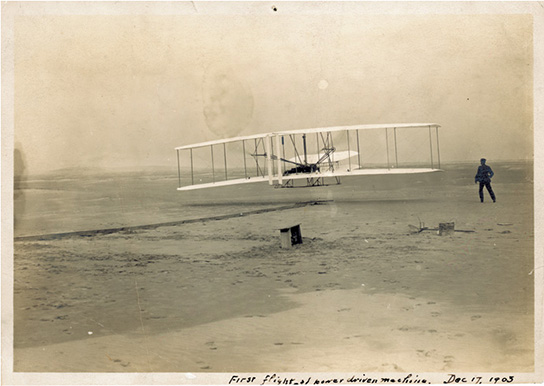7
First Flight
Here’s an excerpt from Orville Wright’s journal, Thursday, 17 Dec 1903:
“When we got up, a wind of between 20 and 25 miles was blowing from the north. We got the machine out early and put out the signal for the men at the station. Before we were quite ready, John T. Daniels, W. S. Dough, A. D. Etheridge, W. C. Brinkley of Manteo, and Johnny Moore of Nags Head arrived. After running the engine and propellers a few minutes to get them in working order, I got on the machine at 10:35 for the first trial. The wind, according to our anemometers at this time, was blowing a little over 20 miles (corrected) 27 miles according to the Government anemometer at Kitty Hawk. On slipping the rope the machine started off increasing in speed to probably 7 or 8 miles. The machine lifted from the truck just as it was entering on the fourth rail. Mr. Daniels took a picture just as it left the tracks.” 1,2
Before the flight Orville had set up their camera3 on a tripod, loaded a 5 × 7" dry-plate, set the shutter (1/50 s), and focused the lens where he hoped the plane might be. He instructed John Daniels, from the nearby life-saving station, to release the shutter bulb just as the Flyer left the rail.
That Orville would specifically note the taking of the picture in his diary is not surprising – the brothers were meticulous about their documentation. Nearly every step of their invention was well represented with letters, diaries, notes, diagrams, and images. They were also enthusiastic and accomplished amateur photographers, even setting up a darkroom in the shed behind their Hawthorn Hill home.4 As Orville stated in a 1901 lecture to the Society of Western Engineers:
“In looking at this picture you will readily understand that the excitement of gliding experiments does not entirely cease with the breaking up of camp. In the photographic darkroom at home we pass moments of as thrilling interest as any in the field, when the image begins to appear on the plate and it is yet an open question whether we have a picture of a flying machine, or merely a patch of open sky.” 5
Back home in Dayton the brothers developed the glass plate and found that Orville had focused at exactly the right spot, Daniels triggered the shutter at exactly the right time, and they ended up not with “merely a patch of open sky” but one of the iconic images of the 20th century. Here are several more photographs documenting their flights taken that day:
Third flight. LOC LC-DIG-ppprs-00628
Fourth flight. LOC LC-DIG-ppprs-00629
Flyer after the fourth flight. LOC LC-DIG-ppprs-00614
The plates went largely unseen for the next decade as the Brothers refused to reveal any details of their experiments and tests while they obtained a patent and tried to sell their flying machines in the US and Europe. Years later, in Mar 1913, the glass plates were submerged in water for several days during the Great Dayton Flood, so by the time the Library of Congress received the glass plates (301 in all) after Orville's death in 1949 the famous photograph looked like above.
In the 1970s the Library of Congress re-photographed the negatives and archived them as 8 × 10 silver-gelatin prints. These were published in 1978 as a set of microfiches (kids, ask your parents or, perhaps, an old librarian) to commemorate the 75th anniversary of flight.6 Finally, in May 2001, the glass plate collection was digitized.7
The photographic copy of the LOC plate is the source for virtually every published image since the 1950s, typically with the damaged edges and broken corner cropped out:
Typical cropped example. NASA
More recently, with the publication of the high-res digital files, a number of images with the damaged areas digitally restored have appeared, such as this excellent example:
There is, however, another source of the iconic image. After the LOC cherry-picked what they considered the most important materials from the Brothers estate the rest, including thousands of photographic prints, stayed with the family until they donated the archives to the Wright State University in 1975. Among these photographs were a number of early silver-gelatin contact prints made from the glass plate. These are now the only remaining versions of the intact, pre-flood, image:
WS 16-2-13. Courtesy of Special Collections and Archives, Wright State University8
WS 16-2-11. Courtesy of Special Collections and Archives, Wright State University
– QED
1. McFarland, Marvin W., ed. The Papers of Wilbur and Orville Wright: Including the Chanute-Wright Letters and the Papers of Octave Chanute. New York: McGraw-Hill, 1953. McFarland is the authoritive text for the brothers’ papers. The best general biography is: Crouch, Tom. The Bishop’s Boys. New York: W.W. Norton, 1989. For the specifics of their gliders and the Flier see Jakab, Peter L. Visions of a Flying Machine: The Wright Brothers and the Process of Invention. Washington and London: Smithsonian Institution, 1990.
2. The first trial, with Orville piloting, covered 120 ft in 12 sec, for an average ground speed of 6.8 mph. This was followed by flights of 175 ft in 13s (Wilbur), 200 ft in 15s (Orville) and 852 ft in 59s (Wilbur). After the fourth flight the plane was tipped over by strong wind gusts and severely damaged. The Wrights packed up the plane and returned it to Dayton – it would never be flown again.
3. The Korona V 5×7" view camera was manufactured by the Gundlach Optical Company, Rochester, New York, and was fitted with a Turner-Reich brass mounted anastigmatic lens, serial #51760, manufactured May 14, 1895. The camera was purchased by the brothers in 1901 at a cost of 85.00 dollars. Years later, Orville gave the camera to his nephew Horace Wright, who donated the camera and equipment to Carillon Historical Park, Dayton. Ohio, in 1984.
4. They were so meticulous that they documented their documentation. Orville often recorded in his notebook the time, date, place, subject matter, and even the f-stop setting and type of plate used for an exposure.
5. Wright, Wilbur. "Some Aeronautical Experiments." Lecture to the Society of Western Engineers. 18 Sept 1901. Reprinted in McFarland (see ref 1).
6. Photographs by the Wright Brothers: Prints from the Glass Negatives in the Library of Congress: a Micropublication Commemorating the Seventy-Fifth Anniversary of the First Flight by the Wright Brothers, December 17, 1903. Washington, DC: Library of Congress, 1978.
7. They were scanned emulsion-side up using an overhead capture MARC II digital camera. Each negative was scanned as a RBG image, 12 bits per channel, at a resolution of 1050 dpi. Note that the uncompressed TIFF files are roughly 230 MB each and, yes, you can download them here.
8. Used here by permission.
20 Dec 2008, updated 10 May 2012 ‧ Photography
